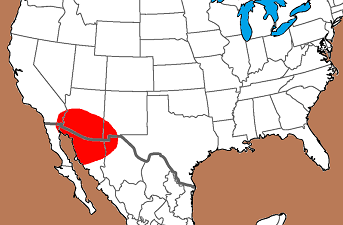Outline is Representative of Size and Shape:

Name Details:
Identified By: Herbert W. Dick
Named For: Chiricahua Phase
Date Identified: 1965
Type Site: Bat Cave, New Mexico
Identified By: Herbert W. Dick
Named For: Chiricahua Phase
Date Identified: 1965
Type Site: Bat Cave, New Mexico
Point Validity:
Valid type
Dick was a distinguished anthropologist and a professor at the University of New Mexico. This type was named in a professional publication and has many professional references to this type. This is considered a valid type.
Dick was a distinguished anthropologist and a professor at the University of New Mexico. This type was named in a professional publication and has many professional references to this type. This is considered a valid type.
Chiricahua Side Notch
AKA: Ventana Side NotchCluster: Northern Side Notch Cluster
Description of Physical Characteristics and Flaking Pattern:
This is a small to medium triangular side notch point with an elliptical to flattened cross section. The blade may vary from excurvate to straight. Examples that are heavily re-sharpened have reduced blades. Parallel notches are shallow C-shaped which forms a wide neck and forms shoulders that are horizontal to having an upward angle. The placement of notches may vary from low to high on the preform. The stem is expanding with a rounded basal margin which are generally wider than the blade. The base is concaved forming basal ears. This point has a random flaking pattern.
Size Measurements:
Total Length - 20 to 75+ mm (average 20 to 25 mm. Exhausted examples may be significantly shorter), Stem Length - 6 to 15 mm, Blade Width - 12 to 22 mm (17 t 18 mm), Neck Width - 9 to 18 mm, Basal Width - 11 to 22 mm, Thickness - 4 to 8 mm
Total Length - 20 to 75+ mm (average 20 to 25 mm. Exhausted examples may be significantly shorter), Stem Length - 6 to 15 mm, Blade Width - 12 to 22 mm (17 t 18 mm), Neck Width - 9 to 18 mm, Basal Width - 11 to 22 mm, Thickness - 4 to 8 mm
Commonly Utilized Material:
Primarily obsidian and basalt followed by chert
Primarily obsidian and basalt followed by chert
Additional Comments:
Justice (2002) feels that this point has been poorly defined and the described characteristics of this type overlay the San Jose point. He feels that this has led to confusion of this point and that the point needs to be re-defined in order to reduce confusion. He has renamed this point Ventana Side Notch.
Justice (2002) feels that this point has been poorly defined and the described characteristics of this type overlay the San Jose point. He feels that this has led to confusion of this point and that the point needs to be re-defined in order to reduce confusion. He has renamed this point Ventana Side Notch.
Distribution:

Distribution Comments:
This point is primarily found on the Coconino Plateau, Chihuahua and northern Sonora and northwestern Chihuahua Mexico. This point may be found into southwestern New Mexico and southeastern California with decreased frequency.
This point is primarily found on the Coconino Plateau, Chihuahua and northern Sonora and northwestern Chihuahua Mexico. This point may be found into southwestern New Mexico and southeastern California with decreased frequency.
Age / Periods:
Date: 4,800 - 2,500 B.P.
Cultural Period: Late Archaic
Glacial Period: Neoglacial
Culture:
Date: 4,800 - 2,500 B.P.
Cultural Period: Late Archaic
Glacial Period: Neoglacial
Culture:
Age Details:
This type is part of the Chiricahua Phase.
This type is part of the Chiricahua Phase.
Other points in this cluster / Related / Associated Points:


